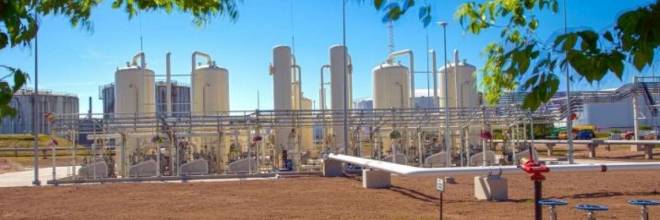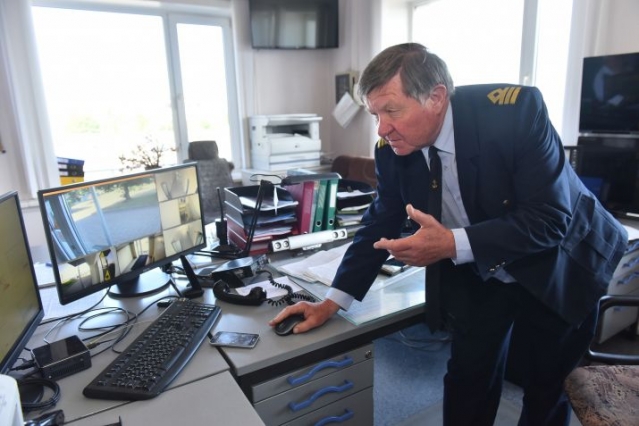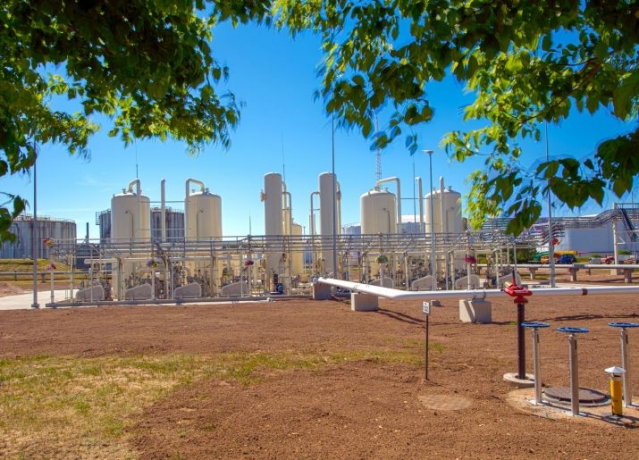VENTSPILS HAS TAKEN A STEP FORWARD IN THE PROTECTION OF THE ENVIRONMENT

Ventspils Freeport has implemented new requirements for businesses that are carrying out cargo operations with petroleum and chemical products. Ventspils Freeport has taken a major step forward in protecting the environment and moving closer to the largest European ports.
New rules have come into effect
Ventspils Freeport has become the first port in Latvia who has introduced a complex control system for the emissions of volatile organic compounds (VOC) and odours from loading oil tankers with petroleum and chemical products. Since June 1, 2018, new provisions are in effect in the area of Ventspils Freeport that stipulate that by loading petroleum or chemical products as well as mazut, crude oil and benzol into vessels whose vapour pressure (by Reid method) is 27,6 kilopascals and more (when t˚ is 37,8 ˚C) the odours and emissions control system is implemented. Following this system, the VOC emission cannot exceed 10 g/Nm3 in the area of the terminal. The operator of the terminal, in which the handling of mentioned products are happening, monitors the odours and sends the data to the harbour master service. Whereas the operator of terminal unloading mazut from rail tank-waggon needs to secure that the odour concentration does not exceed 5 g/Nm3 in public places.
The odour control system is implemented
Ventspils Freeport has been working on this for a long time. One of the terminals, Ventall Terminal that is handling light oil products has been using this system since 2006, tells the Deputy Executive Officer of the Freeport of Ventspils Guntis Drunka. Ventaonjaks Serviss has also purchased the installations for odour and emission control. Moreover, the system used in the terminal, despite having been operating for 12 years, remains modern and effective as it provides a vapour clearance rate up to 10 g/Nm3 in the terminal area and a reduction in VOC emission by 90 - 95%, says Drunka.
Two more businesses, Ventspils Nafta terminal (VNT) and Ventbunkers had to set-up the vapour recovery units (VRU) and implement the odour control system in their territory until May 31, 2018. VNT set-up odour control stations and vapour recovery units within the limited time laid down by Freeport. Ventbunkers is currently in the process and promises to set-up the equipment until the end of the June. On June 1st the continuous monitoring system started operating, controlling both, the odours in the terminal and in public places and VOC emissions from VRU. The electronic “noses” in public places has been installed on Stradiņa iela, Talsu iela 114 and at the city’s waterfront.
On a voluntary basis
The system of controlling odour and vapour emission from petroleum products is not a new invention, accents Druka. Recently he visited two EU ports – Tallinn and Rotterdam studying overseas experience that has been used for around eight years. “I was very impressed by companies and terminals who were introducing this system voluntarily.”
Each country has its own standards. We have a certain admissible level of odour and VOC emission, but in Estonia, for example, the standard is that the odour may not be disturbing, without specifying a certain limit. Whereas in Netherland the main criteria are locals’ complaints, requiring companies to seek for more efficient solutions and invest in order to achieve the desired result.
The port of Rotterdam has installed around 350 electronic “noses” that are owned by both private businessmen and the port administration. “We have taken a big step towards the aim for our terminals not to be disturbing,” concluded Drunka, expressing gratitude to all of the companies that did not spare to invest in this aim.
First results
According to the new rules of Ventspils Freeport, the results of continuous monitoring of odour and VOC emissions must be reported at harbour master’s service. Data are received from nine stations or electronic “noses” installed on terminal borders and in public places. The monitor shows graphics of the odour and VOC emissions actual level and timing in each of all nine stations. Port’s supervisor evaluates the obtained data and requires the terminal operator to take certain actions, including reducing the cargo loading intensity if the VOC limit or the concentration of odour on the terminal border or in public places exceeds the regulatory requirement.
If the operator of the terminal is not responding or the activities performed do not provide the desired results, the port supervisor shall inform the Regional Board of the State Environmental Service. The port supervisor Vladimir Macko tells us that cooperation with port terminals and National Environmental Services is currently under test mode. However, the first results have already been received and summarised.
Mocko points out that since the June 8, when it was nearly a week since the new Freeport rules entered into force, the VNT and Ventall Terminals, who already uses VRU’s, did not exceed the rules. But in the territory of Ventbunkers excess of VOC and odour concentration was monitored at the station near the railway platform where mazut was unloaded from tank-waggons into aboveground storages.
“The first observations suggest the need for the next step – the installation of odour control systems and the installation of VRU in places where tank cars are being drained,” tells Drunka. Specialists in Rotterdam are already developing a control system project for the Tallinn port. It should be mentioned that emissions and odour concentration is much lower when unloading tank-waggons than when loading vessels. “If we succeed in disposing of odours when loading vessels, it would be a significant step forward,” says the Deputy Executive Officer.
*Electronic nose – an electronic device for detecting the odours.

The port supervisor Vladimir Macko views the data on the monitor from nine control stations.
Who needs to be the controller?
Jānis Vītoliņš, 1st Deputy Chairman of Ventspils City Council on Infrastructure Affairs
Currently the odour control system is a partly introduced in terminals handling petroleum products. SIA Ventas nafta terminals has set-up the vapour recovery units and brought them into service, but AS Ventbunkers is currently doing construction work. At the same time with the establishment of these units, each of the petroleum product handling companies has set-up three electronic noses in the area of their territories. Together there are nine electronic noses working now in Ventspils which are continuously measuring the odour level. Efficient work of these control devices can be assured only if they are constantly monitored and controlled. Unfortunately, we have not come to a mutual agreement on who is supposed to control the compliance with the binding rules set out by the port and municipality. We multiple times addressed the State Environmental Service administration as well as the Ministry of Environment Protection and Regional Development of the Republic of Latvia drawing attention to the fact that this control must be carried out by the State Environmental Service in accordance with the law On Pollution, in our case, by Ventspils Regional Environmental Board. But the State Environmental Service has different views: the binding rules of municipality needs to be controlled by the municipality. It is absurd because the amendments as provided for by the law On Pollution determines control only from one institution, the State Environmental Service. We have all the juridical conclusions needed and we are going to repeatedly address the Ministry. The State Environmental Service believes that the new system of odour control is primarily needed for the self-control of the companies. Unfortunately, the citizens of Ventspils have ascertained throughout many years that companies’ self-control is not efficient. By meeting the administration of the State Environmental Service for several times, municipality assured that the information from electronic “noses” is sent not only to the harbour master service but also to Regional Environmental Board. It is therefore unclear why, in the case of exceeding the limitation, the inspector of the Regional Environmental Board is waiting for a call from harbour master service and why the inspector does not react immediately. Consequently, the municipality is going to relentlessly request the implementation of the binding rules, i.e. AS Ventbunkers needs to complete the establishment of vapour recovery units as soon as possible and the State Environmental Service must ensure effective control.
We are all learning
Inguna Pļaviņa, the Director of Ventspils Regional Environmental Board
The odour controlling and monitoring system has just begun to operate in the city. In our view, an obvious advantage of this system is that we can see a detailed layout of the actual situation. So far we had accumulated a lot of experience at the odour evaluation with sent. We are able to detect more intense and weaker odours but this evaluation will be supplemented with a detailed numeral outline. Since June 1, when the odour control system were introduced in the city, none significant violations have been registered. When we received one complaint about odours in a public area, the value, in this case, were two odour evaluation units, when the norm the norm is five units. Turned out that at this time in terminal Ventbunkers mazut was being unloaded from rail-waggons. We knew about the environmental impact of mazut unloading platforms already before and now we have the opportunity to also control its odour pollution. The system is flexible and it can always be supplemented with new electronic “noses”. The Regional Board of the State Environmental Service is now working on a new collaboration with Ventspils Freeport Authority, introducing an odour monitoring system. Ventspils Freeport Authority also receives the results of monitoring. We agreed to exchange information and meet to discuss the most topical issues, if necessary. We are all only learning now.
The main purpose of odour monitoring is an early warning of any unpleasant situation in connection with odours. First of all, it is needed for the supervisor of the terminal to understand the possible consequences and needed actions. There are no additional legal obligations or functions imposed on us by the new port rules because the provisions of the Cabinet of Minister on odour control have not changed. We will, as before, react to complaints from citizens and draw up protocols as well as control the polluting activities of companies and follow whether the conditions of issued permits are met.
We are proud to contribute to the city.
Lars Pantzlaff, VNT Managing Director
During the last nine months, the VNT focused all its efforts on the construction of the vapour recovery units (VRU), to meet the official deadline (May 31, 2018) when the use of VRU became mandatory. During May, VRU were already operating in test mode, but now the VNT uses the VRU as an integral part of vessel handling. We are proud of the opportunity to be a contribution to the improvement of the city’s environmental standards and the well-being of the citizens. This achievement was possible only due to the inexhaustible efforts of our project team. VNT employees, contractors, and suppliers were successfully working side by side. We received the investment and equally high support also from other instances, such as the municipal government, Ventspils Freeport Authority, State Environment Service as well as from several Ventspils companies. VNT wants to express its gratitude to all the parties involved and especially its project team for the fantastic work!

Facts on VNT vapour recovery unit (VRU)
- 155 000 working hours have been invested in the realisation of the project and there have been 0 accidents during this process.
- VRU consists of two identical vapour recuperation systems.
- 3 electronic “noses” are installed in the territory of VNT to control the diffusion of the odours.
- VRU will be used at 4 docks during the handling of vessels.
- The project involved specialists from 5 countries, of 8 nationalities. 6 leading companies participated in the realisation of the project.
- 7 million EUR has been invested into VRU.
- Construction works lasted for nine months.
- The designed limit for VRU: 10 g/Nm3 VOC emission.